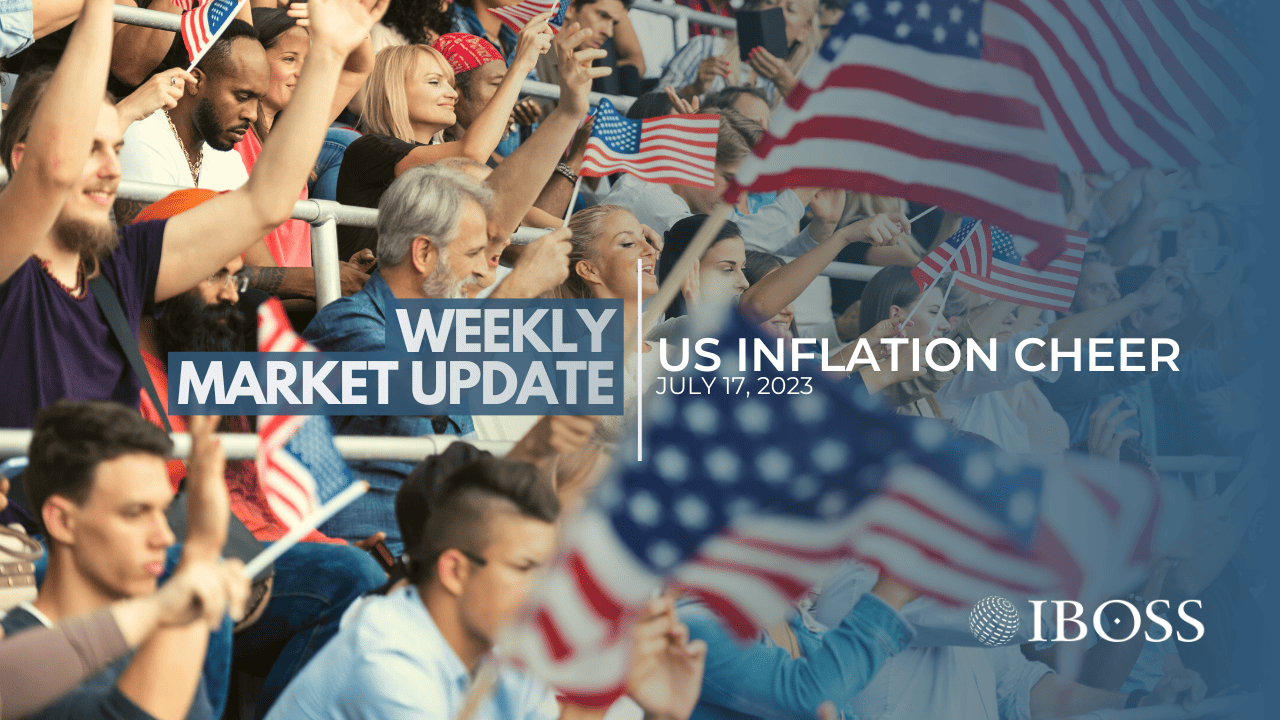
Global equities rose 2.5% last week in local currency terms, more than reversing their fall the previous week and re-establishing the upward trend seen over the last couple of months. However, markets in sterling terms were up a more modest 1.1%, as the pound rallied further against the dollar to $1.31, and are little changed over recent months.
Fixed income also had a good week with Treasuries and Gilts both returning around 1.5% as yields retreated 0.2% from their recent highs. The main catalyst for these gains was the better-than-expected US inflation data for June.
The headline rate fell from 4.0% to 3.0%, a far cry from last year’s high of 9% (and also for that matter the UK, where Wednesday’s numbers should show inflation slowing but only to 8.2%). This decline means that wages are now rising in real terms, rather than falling, removing one of the big sources of downward pressure on the economy.
Consumers are as a result feeling considerably more cheery and confidence recovered further in July to close to a two-year high. The second quarter results of the big three US banks on Friday also showed no sign of any major rise in consumer distress. Instead, the banks continue to benefit from the rise in interest rates.
But for the Fed at least, it is the core rather than headline inflation rate which is its main focus. This also fell more than anticipated from 5.3% to 4.8% but remains well above the 2% target. The Fed is therefore still far from opening the champagne and still looks set to raise rates by a further 0.25% to 5.25-5.5% next week.
In contrast to the US, where markets have taken heart from renewed hopes that we could be on track for a soft-landing rather than the much-forecast recession, sentiment on China could not be much worse. Today’s batch of economic numbers did little to inject much cheer.
Chinese growth, as expected, slowed considerably in the second quarter, with GDP rising 0.8% following the 2.2% post-covid jump seen the previous quarter. The more up-to-date activity numbers for June also painted a relatively downbeat picture and the official 5% growth target for this year is now starting to be called into question.
Even so, the pessimism is now looking overdone, just as the optimism on the US and the Magnificent Seven (the latest name for the clutch of tech titans driving the US market higher this year) is looking rather overblown. Chinese GDP growth is still likely to be more than double that of the US this year and next, while the equity market trades on a price-earnings ratio of only 10.4x, almost 50% lower than the US.
Furthermore, whereas the Fed is still not quite done with raising rates, the Chinese authorities look certain to ease policy over coming months. Inflation is running at zero and youth unemployment is over 20%, providing every incentive to do so. The hope is that a politburo meeting later this month will endorse such action.
Back here in the UK, where equities also trade on a P/E ratio of only 10.4x and look exceptionally cheap, the economic backdrop remains troubling. The picture so far remains one of activity stagnating rather than contracting, with GDP unchanged in the three months to May, but a dip into recession remains a real risk.
The squeeze on real incomes may now be moderating but only slowly and much of the pain from higher mortgage rates has still to feed through with the average two-year fixed rate now up to 6.8%. Last week’s numbers showed underlying wage growth running at a worryingly high 7.3% across the economy and 7.7% in the private sector. Barring a major shock in Wednesday’s inflation numbers, the Bank of England looks set to raise rates by another 0.5% to 5.5% in early August.
One UK asset which has benefited from the ramping up of the expected peak for UK rates is the pound. That said, its gains last week were down to dollar weakness and any further strength from here should be primarily down to a further decline in the US currency which continues to look overvalued. Famous last words but market expectations of UK rates peaking at over 6% do look somewhat overblown.
This communication is designed for professional financial advisers only and is not approved for direct marketing with individual clients. These investments are not suitable for everyone, and you should obtain expert advice from a professional financial adviser. Investments are intended to be held over a medium to long term timescale, taking into account the minimum period of time designated by the risk rating of the particular fund or portfolio, although this does not provide any guarantee that your objectives will be met. Please note that the content is based on the author’s opinion and is not intended as investment advice. It remains the responsibility of the financial adviser to verify the accuracy of the information and assess whether the OEIC fund or discretionary fund management model portfolio is suitable and appropriate for their customer.
Past performance is not a reliable indicator of future performance. The value of investments and the income derived from them can fall as well as rise, and investors may get back less than they invested.
IBOSS Asset Management is authorised and regulated by the Financial Conduct Authority. Financial Services Register Number 697866.
IBOSS Asset Management Limited is owned by Kingswood Holdings Limited, an AIM Listed company incorporated in Guernsey (registered number: 42316).
Registered Office: 2 Sceptre House, Hornbeam Square North, Harrogate, HG2 8PB. Registered in England No: 6427223.
IAM 204.7.23

